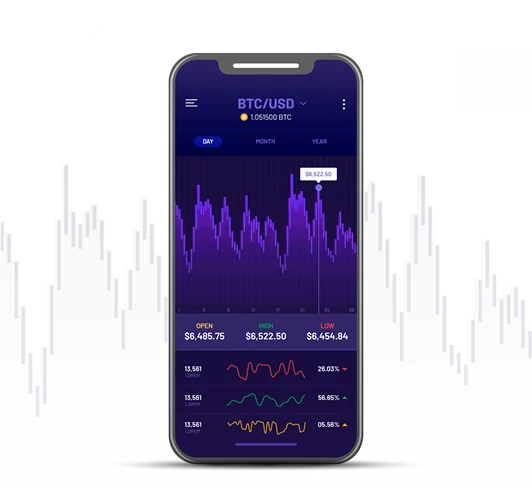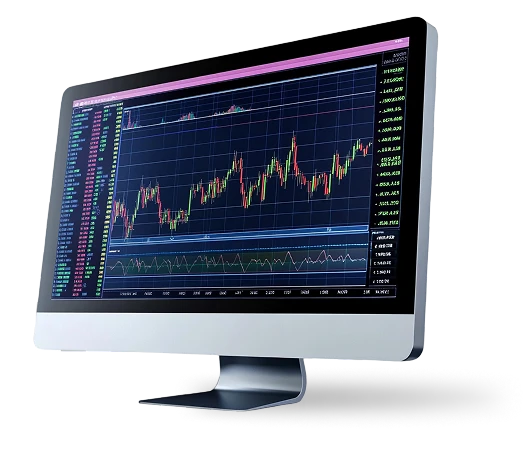Bexlorit enhances crypto trading by prioritizing traders in the market. It does this through its AI trading bot that provides traders with insightful data about the market, price movements, or trading trends.
With Bexlorit, traders do not have to worry about their level of expertise, as the AI bot will assist them. Traders can also rest assured that their data and endeavors are secure on the platform. They can also trade around the clock on the platform.
To start trading on Bexlorit, people should sign up by providing their names, emails, and phone numbers. They should also provide their preferred usernames and emails to create their accounts. After these, Bexlorit will provide them with the necessary trading tools immediately.

Traders can never miss important crypto market insights or price forecasts. By registering on Bexlorit, traders will receive trading tips, identify open positions, and get market indicators. These can help traders make informed trading decisions. Sign up on Bexlorit to explore different crypto markets.

An objective trading experience is not a one-time thing on Bexlorit. The platform continually uses its machine-learning abilities to improve trading strategies. Also, it analyzes past data to detect trading patterns and adapt to changing market conditions. Register on Bexlorit to trade with AI.

People can still interact with the market even when not present to monitor their trades. Bexlorit’s trading bot relieves traders of the stress of constant monitoring, as it can trade 24/7. This process ensures adaptability as the bot acts fast when there is an opportunity to take. Sign up on Bexlorit to enjoy automated trades.
Bexlorit can adapt to different markets, whether sideways, bull, or bear. It adjusts trading strategies based on analyzing market conditions and performance. Want to redefine trading endeavors? Register on Bexlorit.

Millions of people can use Bexlorit simultaneously without experiencing lag. The platform never has downtime. It is accessible on all operating systems and mobile or desktop devices. Sign up to create an account on Bexlorit for a smooth trading experience.
Bexlorit is free for all crypto traders. The platform does not charge registration fees or for using its trading tools. Despite this, it fully supports traders, helping them manage risks and make informed decisions. Want to use Bexlorit’s trading tools for free? Then, simply sign up.
The platform supports traders (new or experienced) with crypto knowledge. The information shared on the platform also helps them understand how the crypto market works.
Cryptocurrency is a digital currency issued, bought, sold, and exchanged online. While it is a digital currency, it can be converted into fiat currency, which can be withdrawn physically. USDT, Bitcoin, Ethereum, Tron, and Bitcoin are the common crypto types. People often trade cryptocurrencies to make gains. Yet, positive returns are not always guaranteed due to risks and volatility. Bexlorit analyzes some crypto trading tools below:
This technical analysis method uses Fibonacci ratios to determine price levels (38.2%, 50%, and 61.8%) for stop-loss, entry, and exit positions. Traders use this method to understand trend corrections and continuations. Fibonacci retracements can be visualized. They support trend analysis and work well with other technical indicators. On the other hand, this method is not reliable in volatile markets. It can produce unclear results when combined with too many technical indicators.
The Aroon Indicator measures a trend’s strength and identifies its beginning/changes. It also identifies a ranging market and spots retracements. The indicator may give poor trading signals during choppy market action. To use the Aaron Indicator for trading, register on Bexlorit.
This tool identifies the strength of a cryptocurrency’s price trend. It goes toward a strong trend, helping traders manage risk and spot opportunities. To determine ADX, Bexlorit’s AI calculates directional movement and true range.
This tool allows traders to make informed decisions. Traders use it to calculate position sizes, trading costs, exchange rates, trading results, and roll-over fees. When choosing a trading calculator, traders often consider margin, swaps, spread, percentage in point (PIP) cost, and commissions.
This continuation pattern shows when a trade experiences a large upside or downside movement. It also goes through a consolidation period before moving in the same direction again. It forms for days or weeks. The phases of a pennant pattern are the first flagpole, the pennant pattern, and the second flagpole.
The first flagpole is the first strong movement to the upside or downside. The pennant pattern is the period where two converging trend lines consolidate. The second flagpole is when the pennant pattern breaks out in the first flagpole’s direction. A pennant pattern can be bullish or bearish.
While trading a bullish pennant pattern, traders set limit buy orders at the upper trendline. Traders confirm a pennant pattern breakout by looking for above-average volume on the upper trendline breakout. In a bearish pennant pattern, traders set a short limit order at the lower trendline. Here, traders confirm a pennant pattern breakout by looking for above-average volume on the lower trendline breakout.

Trade calculators perform a few functions. First, it helps traders identify exchange rates and convert cryptocurrencies to fiat currencies. Also, people can trade or invest their cryptocurrencies appropriately by identifying exchange rates. That is, they will not overfund or underfund their accounts when trading. Traders will also have up-to-date exchange rates to work with.
A margin calculator helps traders know the margin size to maintain to support an open position. Calculating a margin shows traders how to avoid margin shortfall. To decide a trading margin, the calculator multiplies the position size with the entry point and divides the result with leverage.
A PIP value is more easily determined with a trading calculator. The tool shows traders their PIP value to manage their risk per trade. Also, it shows currency value as they fluctuate. A trader needs the currency in their account and the currency pair traded to know a PIP value. They also need their position size and the exchange rate for calculating the PIP value.
Calculating trading costs helps traders understand the expenses they will incur and how they affect their possible gains. Transaction costs include brokers’ commissions and spreads. In some cases, traders might be required to pay ongoing fees instead. Want to start trading without the fear of trading costs? Sign up on Bexlorit.
A trading calculator helps traders decide how much cryptocurrency to buy or sell. In other words, it shows how much money to allocate to a trade. The calculator determines a trader’s position (whether long or short) based on their account balance and risk tolerance.
Traders are often eager to know the outcome of a particular trade, whether it will yield gains or losses. A trading calculator relies on a trader’s position size to better calculate their trading results. Use Bexlorit’s AI bot to automate trading performance assessment. To start, simply register.

Cryptocurrency is risky like other assets. Hence, one of Bexlorit’s reasons for employing an AI bot is to help people trade strategically. Some cryptocurrency risks include low liquidity, volatility, hacking, and human error. Cryptocurrencies have low liquidity as they cannot be exchanged for cash easily, unlike stocks and bonds. This way, traders might experience slippage.
Crypto prices are unstable. The prices can fluctuate several times daily or weekly, making it highly risky. The fluctuations could be due to public sentiment, protocol updates, and world news. Also, increased cyber crimes like hacks and scams make crypto trading risky. Hackers often target traders and investors, blockchains, and trading platforms. Bexlorit is protected from hacks, helping people trade confidently and have suitable control of their accounts.
Human error poses huge risks in crypto trading. At times, traders might make fat finger errors. These include transferring the wrong currency, buying the wrong coin at the wrong price, and paying excessive fees. Also, traders might forget their private keys, causing them to lose their accounts and crypto assets.
Risk mitigation strategies in crypto may minimize identified risks. These approaches are designed to reduce exposure to future losses and protect capital. The mitigation strategies include using stop-loss orders, diversification, technical and fundamental analysis, and secure platforms. Stop-loss orders allow traders to set sell orders if their trade has a certain percentage loss. They also minimize losses and provide an exit plan when a trade goes in the wrong direction.
Diversification involves owning a portfolio of different cryptocurrencies. For instance, a trader can invest in stablecoins, altcoins, and established coins. When mixing cryptocurrencies, traders should consider each coin’s risk-return profile and how the coins correlate. This combination may hedge against certain risks. While traditional diversification has its pros, it increases complexity as it involves managing different coins, wallets, and exchanges. However, Bexlorit’s AI is suitably equipped to inform, automate, and manage diversification strategies.
Technical analysis on Bexlorit provides trading volumes, chart patterns, and historical price data. These data help traders predict price movements, identify trends, and know suitable trade entry and exit points. Relative strength index, Bollinger Bands, and oscillators are common technical indicators. Fundamental analysis identifies the factors driving crypto prices. These include macroeconomic trends, regulatory development, and technology adoption. Price-to-sales ratio, dividend yield, price-to-earnings ratio, and return on equity are examples of fundamental analysis indicators.

A cryptocurrency airdrop is a small amount of coin sent to the wallets of active traders of a blockchain community. The coin is sent for free or for a small amount. It is a promotional strategy a startup uses to create awareness and increase the coin’s circulation. Crypto airdrop types include exclusive, bounty, raffle, standard, and holder. An exclusive airdrop is sent to certain people. The selection criteria are the number of posts in a forum, time spent on a project, and the money spent on a non-token activity.
A bounty airdrop is given to those who perform certain tasks. The task could be to retweet a startup’s tweet about its new coin or raise awareness on social media. The startup may also give finder’s fees or referral bonuses to those who sign up for other users. A user can receive a raffle airdrop by earning a raffle ticket through earning points, expressing interest, or holding tokens.
A standard airdrop is received by showing interest only. On the other hand, a holder airdrop is received automatically depending on who holds existing tokens and the amount held. Users must do their due diligence before receiving an airdrop to avoid scams. While airdrops reward early adopters, they pose huge security threats. Though marketing raises awareness about an airdrop, people can still perceive it as a pump-and-dump scheme.

Here are some terms to help traders understand cryptocurrency better: crypto staking, blockchain, altcoin, seed phrase, token, and consensus mechanism. Crypto staking is locking cryptocurrencies in a blockchain network to get possible rewards. The process also helps people support their favorite blockchain networks. Staking types include staking pools, exchange, direct, liquid, and delegated.
A blockchain is a shared and decentralized platform that records transactions in a network. It could be public, private, hybrid, or consortium. A public blockchain allows everyone to enter the network (requires no permission). On the contrary, a private blockchain requires permission and restricts access to a group of people. A hybrid blockchain combines the features of a private and public blockchain. A consortium blockchain is a hybrid blockchain governed by a group of organizations.
An altcoin is any cryptocurrency different from Bitcoin. It includes meme coins, stablecoins, security tokens, and play-to-earn tokens. Altcoins help the late majority of adopters understand that cryptocurrency is not limited to Bitcoin’s utility. Before buying an altcoin, traders must confirm its real-world application, especially if it is a token.
A seed phrase, also a recovery phrase, is a unique word string that serves as a crypto wallet’s master key. A person must create a cryptocurrency wallet to generate a seed phrase. The wallet software creates a random seed phrase that generates the user’s wallet’s private keys. The user can now derive public addresses from the private keys.
A token is a digital asset. It could be non-fungible, governance, or utility. A non-fungible token (NFT) includes gaming assets, royalties, and digital art. NFTs are unique and cannot be traded for one another. A governance token gives people voting and decision-making power within a blockchain network. A utility token serves as the currency accepted on a network. It allows people to pay for a service or unlock certain features on the network.
Mining is adding blocks to a proof-of-work (PoW) blockchain. Processing a pool of crypto transactions with mining involves seven steps. First, incomplete crypto transactions are grouped into a pool. Then, unverified transactions are used to form a block. Miners solve a complex math puzzle, and the fastest miner announces the solution. After this, other miners verify the solution’s accuracy. If correct, a block is added to the blockchain, and the miner gets a reward.
A cryptocurrency exchange is a platform where people can buy, sell, or exchange coins. It could be centralized, decentralized, or peer-to-peer (P2P). An exchange could also be a cryptocurrency retailer or a derivative trading platform. A centralized exchange is regulated as it connects crypto buyers and sellers. This platform is secure but charges high transaction fees. Sign up on Bexlorit for a suitable experience in crypto trading.
A decentralized exchange allows transactions and holds assets without a third party. It requires less censorship and may prevent market manipulation. On the contrary, it lacks liquidity.
| 🤖 Signup Expense | Completely free registration |
| 💰 Charges Applied | No hidden charges |
| 📋 Sign-Up Method | Straightforward, fast registration |
| 📊 Educational Topics | Focused learning in Cryptocurrency, Forex, and Investments |
| 🌎 Countries Available | Operational in most countries, excluding the USA |